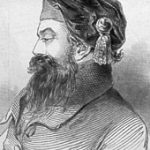NICHOLSON, JOHN (1821-1857), political assistant at Firozpur (1844-45), was born in Dublin on 11 December 1821, the son of Dr Alexander Nicholson. He obtained cadetship in Bengal Infantry in 1839 and in December the same year was posted to the 27th Native Infantry at Firozpur. In 1844, he became political assistant at Firozpur in which capacity he was found indulging in intrigues against the Sikh State and Lord Hardinge felt inclined to remove him from the frontier.
GORDON (d. 1837), often miscalled Canon, an Anglo Indian, entered the service of Maharaja Ranjit Singh in 1820 as an infantry instructor on a salary of Rs 500 per month. Later, he was put in command of a battalion of artillery. In July 1822, his battalion received approbation from Allard and Ventura and was ultimately incorporated in the FaujiKhas. Gordon was now charged with raising a new cavalry regiment to be called Akal Regiment.






